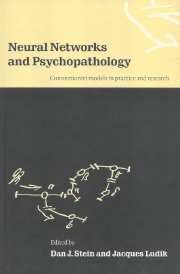Book contents
- Frontmatter
- Contents
- List of contributors
- Preface
- Part one General Concepts
- Part two Clinical disorders
- 7 The nature of delusions: a hierarchical neural network approach
- 8 ‘Produced by either God or Satan’: neural network approaches to delusional thinking
- 9 Neural network modelling of cognitive disinhibition and neurotransmitter dysfunction in obsessive–compulsive disorder
- 10 The fables of Lucy R.: association and dissociation in neural networks
- 11 Neural network analysis of learning in autism
- 12 Are there common neural mechanisms for learning, epilepsy, and Alzheimer's disease?
- Epilogue
- Index
7 - The nature of delusions: a hierarchical neural network approach
from Part two - Clinical disorders
Published online by Cambridge University Press: 12 January 2010
- Frontmatter
- Contents
- List of contributors
- Preface
- Part one General Concepts
- Part two Clinical disorders
- 7 The nature of delusions: a hierarchical neural network approach
- 8 ‘Produced by either God or Satan’: neural network approaches to delusional thinking
- 9 Neural network modelling of cognitive disinhibition and neurotransmitter dysfunction in obsessive–compulsive disorder
- 10 The fables of Lucy R.: association and dissociation in neural networks
- 11 Neural network analysis of learning in autism
- 12 Are there common neural mechanisms for learning, epilepsy, and Alzheimer's disease?
- Epilogue
- Index
Summary
For more than 300 years, delusions have been defined as ‘pathological beliefs’ (Berrios, 1996; Spitzer, 1990; see Table 7.1 for clinical examples). During the first half of the nineteenth century, Baillarger reinforced this view by suggesting that ‘form’ be distinguished from ‘content’ (Berrios, 1994). Analysis of content (i.e. of the semantics of ‘belief’) has since then generated clinical subtypes (e.g. depressive versus schizophrenic delusions) (Sérieux and Capgras, 1909; Jaspers, 1963; Moor and Tucker, 1979; Sims, 1988), supported psychoanalytical interest in symbols, and (more recently) encouraged correlational research, for example with biographical data, particularly amongst those interested in attribution theory (Bentall, 1994). The ‘pathological belief’ view has, in general, been less useful to the neurobiological study of delusions (Berrios, 1991; Fuentenebro and Berrios, 1995). Analysis of the form of delusions has also been useful in some cases. For example, it has led to stable diagnostic categories (Schneider, 1959; Jaspers, 1963), and to multidimensional approaches, whose main consequence has been the erosion of the old, categorical, ‘all-or-none’ view. Whether from the perspective of content or of form, most research has been cross-sectional and hence uninformative on how delusions actually change with time. Notable exceptions to this approach have been the work of Kendler, Glazer and Morgenstern (1983) and Garety and Hemsley (1994).
The multidimensional approach is not free from problems. For example, some dimensions of delusions such as ‘bizarreness’ remain ambiguous (Monti and Stanghellini, 1993). Borrowed from Kurt Schneider (Goldman et al., 1992), the term originally meant ‘ absurd ’, ‘ impossible ’ or ‘ contrary to common knowledge ’ (e.g. as in DSM-III-R: APA, 1987).
- Type
- Chapter
- Information
- Neural Networks and PsychopathologyConnectionist Models in Practice and Research, pp. 167 - 188Publisher: Cambridge University PressPrint publication year: 1998
- 2
- Cited by



